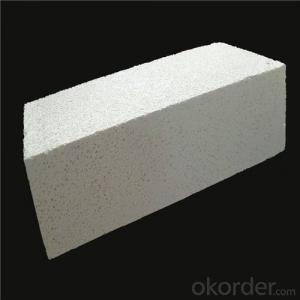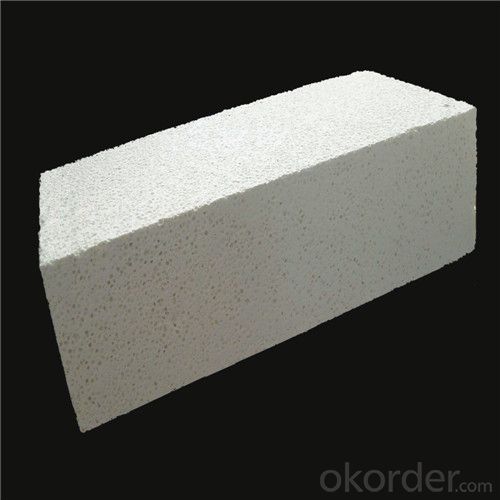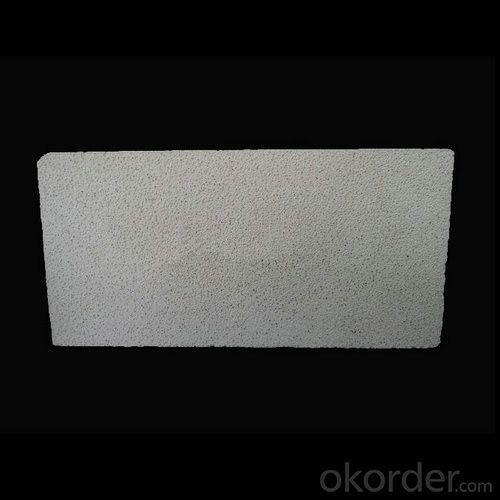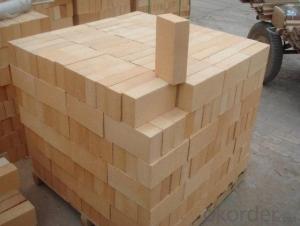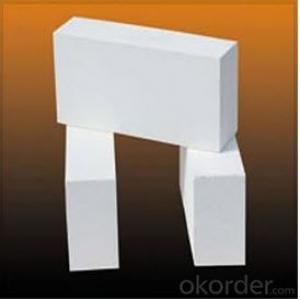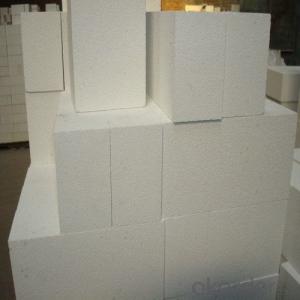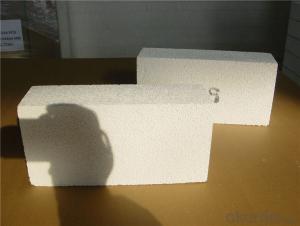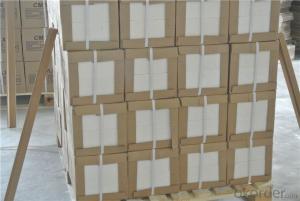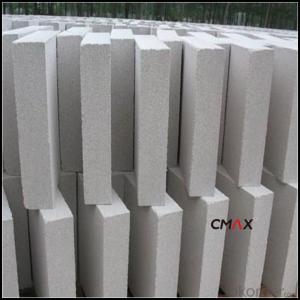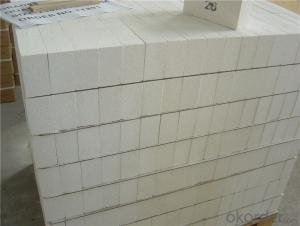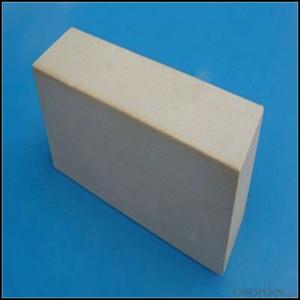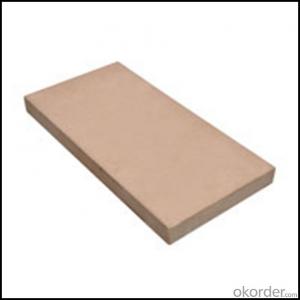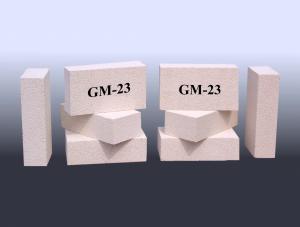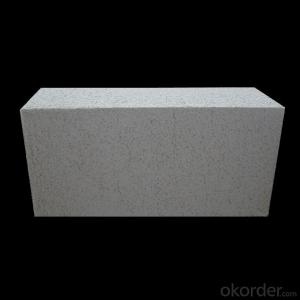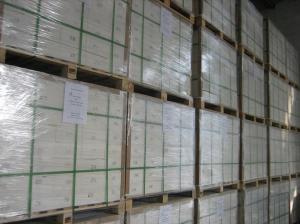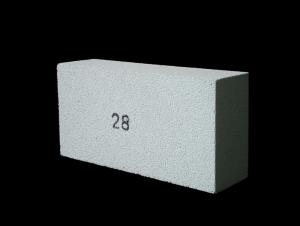Insulating Fire Bricks - High Quality Refractory Clays with Excellent Thermal Insulation
- Loading Port:
- Shanghai
- Payment Terms:
- TT OR LC
- Min Order Qty:
- 1 m.t.
- Supply Capability:
- 1000000 m.t./month
OKorder Service Pledge
OKorder Financial Service
You Might Also Like
Refractory clays insulating firebricks/good thermal insulation bricks:are made of Mullite material in good purity.In order to meet the thermal and physical requirements,we produce BJM insulating firebricks into several grades through the addtion of alumina.And we also add some material (which will burns out) to get the pole structure which is helpful for the heat thermal. This kind product used for oven/ furnace and some equipments working in high temperature by back-up insulation behind other refractories.The production of these goods are strictly in size and quality.
Advantages of Refractory clays insualting firebricks/good thermal insulation bricks:
• Made of high pure material,light weight • Color pure white • Good thermal conductivity • Great thermal shock resistance • very good volume stability at high temperature |
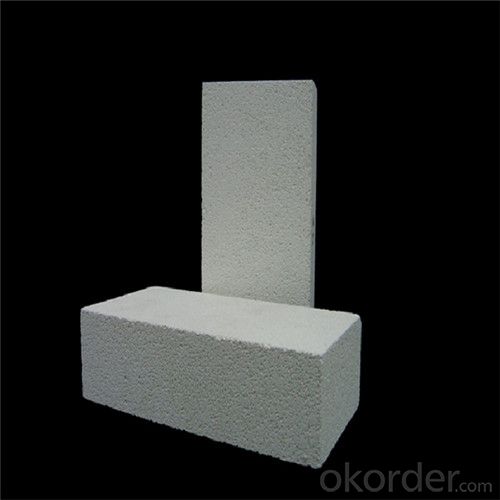
Teachnical Date sheet ofRefractory clays insulating firebricks
/good thermal insulation bricks:
| Grade | Density(kg/m3) | Cold crushing strenth(Mpa) | Thermal Conductivity(400°c/600°c) | AL2O3 | SiO2 | Fe2O3≤% | Linear change≤% | Thermal shock resistance times |
| BJM23 | 600 | 1.2 | 0.18/0.20 | 41 | 54 | 1 | 1250*12/0.5 | >20 |
| BJM26 | 800 | 1.6 | 0.25/0.30 | 55 | 41 | 0.8 | 1400*12/0.5 | >20 |
| BJM28 | 900 | 2.0 | 0.33/0.35 | 65 | 31 | 0.7 | 1500*12/1.0 | >20 |
| BJM30 | 1000 | 2.5 | 0.40/0.42 | 73 | 25 | 0.7 | 1600*12/1.0 | >20 |
| BJM32 | 1200 | 2.8 | 0.45/0.50 | 76 | 20 | 0.8 | 1650*12/1.0 | >20 |
Application
Refractory clays insulating firebricks/good thermal insualtion bricks:
• Backup lining for fireclay brick and high alumina brick in boilers,ceramic kiln,reheating furnace,glass furnace,periodic kiln and high efficiency incinerators,etc. • Backup lining of cyclone preheaters and cooler in cement plant,hot gas generator,hot air direat stack and floor lining for kiln car,etc. |
FAQ
Q4: What is the minimum quantity?
A4: There is no minimum order quantity. Depending on the item and processing, there may be a minimum production required, however we can offer a quotation based only on the quantity you need.
Q5: Can you give me a brief introduction of the application of your products?
A5: CNBM (China National Building Material) core refractory business comprises the production, sale and installation of high-grade refractory products, the development and implementation of customized system solutions as well as rendering outstanding services for the key industries in Glass, Iron& Steel, Petrochemical, Cement, Ceramic and Nonferrous Metals.
- Q: Can insulating fire bricks be used in the construction of industrial dryers?
- Yes, insulating fire bricks can be used in the construction of industrial dryers. Insulating fire bricks are specifically designed to have low thermal conductivity, which means they are able to retain heat and prevent heat loss. This makes them an excellent choice for applications that require high temperatures, such as industrial dryers. Insulating fire bricks are made from lightweight materials such as clay, silica, and alumina, and are capable of withstanding temperatures of up to 3000°F (1650°C). They have excellent insulation properties, which help to reduce energy consumption and improve the overall efficiency of the industrial dryer. Additionally, insulating fire bricks are resistant to thermal shock, meaning they can withstand rapid temperature changes without cracking or breaking. This is particularly important in industrial dryer applications, where temperatures can fluctuate quickly. Overall, insulating fire bricks are a suitable choice for the construction of industrial dryers due to their low thermal conductivity, high temperature resistance, and ability to withstand thermal shock.
- Q: Can insulating fire bricks be used for insulation in cold storage facilities?
- Yes, insulating fire bricks can be used for insulation in cold storage facilities. Insulating fire bricks are made from lightweight materials with high insulating properties, such as ceramic or refractory fibers. They have low thermal conductivity, which means they can effectively prevent heat transfer and maintain a stable temperature inside the cold storage facility. The bricks are also resistant to extreme cold temperatures and can withstand thermal shock, making them suitable for use in cold storage applications. Additionally, insulating fire bricks are durable and can provide long-term insulation, reducing energy consumption and maintaining the desired temperature for storing perishable goods.
- Q: Are insulating fire bricks resistant to high-velocity gas flow erosion?
- Yes, insulating fire bricks are generally resistant to high-velocity gas flow erosion. These bricks are specifically designed to withstand extreme temperatures and harsh conditions, including erosive environments. They are made from high-quality refractory materials, such as alumina and silica, which have excellent resistance to erosion and corrosion. Additionally, insulating fire bricks have a low thermal conductivity, which helps to reduce heat loss and maintain their structural integrity even under high-velocity gas flow. However, it is important to note that the exact resistance may vary depending on the specific composition and manufacturing process of the insulating fire bricks.
- Q: Can insulating fire bricks be used for insulation in autoclaves?
- Insulating fire bricks have the capability to be utilized for insulation within autoclaves. These bricks are specifically engineered to possess a minimal thermal conductivity, enabling them to proficiently retain heat and endure elevated temperatures. The insulation of autoclaves necessitates the ability to sustain a steady temperature and pressure, and insulating fire bricks excel in delivering exceptional insulation properties amidst these challenging circumstances. Furthermore, their robustness and durability render them well-suited for enduring the rigorous heat and pressure fluctuations commonly encountered in autoclaves. All in all, insulating fire bricks emerge as a dependable and efficient option for insulating autoclaves.
- Q: Can insulating fire bricks be used in the construction of pottery molds?
- Insulating fire bricks are indeed applicable for the construction of pottery molds. Crafted from lightweight refractory materials, these bricks possess exceptional heat insulation qualities. Specifically engineered for high-temperature applications like pottery kilns, they offer a range of benefits. When constructing pottery molds, it is imperative to utilize materials that can endure the kiln's intense heat. Insulating fire bricks can withstand temperatures of up to 3000°F (1650°C), rendering them ideal for pottery mold construction. They provide insulation to prevent heat dissipation and maintain consistent temperatures within the kiln, crucial for achieving the desired firing results. Moreover, insulating fire bricks can be conveniently shaped and cut to suit the designated mold design. Their lightweight nature also simplifies handling during the mold construction process. Additionally, the insulating properties of these bricks curtail energy consumption by preventing excessive heat loss, making them a cost-effective choice in the long term. All in all, insulating fire bricks prove to be a fitting option for constructing pottery molds due to their capacity to withstand high temperatures, offer insulation, and be easily molded to meet specific design requirements.
- Q: Are insulating fire bricks suitable for use in steel mills?
- Yes, insulating fire bricks are suitable for use in steel mills. Insulating fire bricks are made from lightweight materials that have high insulating properties, allowing them to withstand high temperatures and provide effective insulation. In steel mills, where extremely high temperatures are generated during the steelmaking process, insulating fire bricks are used to line furnaces, kilns, and other high-temperature applications. These bricks help to reduce heat loss, improve energy efficiency, and protect the steel mill equipment from excessive heat. Additionally, insulating fire bricks have good thermal shock resistance, which is essential in steel mills where rapid temperature changes occur. Overall, the use of insulating fire bricks in steel mills is a reliable and effective solution for maintaining high-temperature environments and optimizing the steelmaking process.
- Q: Can insulating fire bricks be used in refractory lining for steelmaking?
- Insulating fire bricks can indeed be utilized for refractory lining in the steelmaking industry. Crafted from lightweight ceramic materials, these bricks possess remarkable thermal insulation properties. Consequently, they prove to be highly suitable for applications involving elevated temperatures, such as steelmaking, where the maintenance of a consistent temperature is of utmost importance. By incorporating insulating fire bricks, heat loss can be minimized, energy efficiency can be enhanced, and insulation against the extreme temperatures encountered in steel production can be provided. Moreover, these bricks exhibit resistance to thermal shock, a vital characteristic for withstanding sudden temperature fluctuations during the steelmaking process. Consequently, the utilization of insulating fire bricks within refractory lining for steelmaking purposes can significantly optimize the performance and efficiency of the entire steelmaking operation.
- Q: Can insulating fire bricks be used in lime plants?
- Yes, insulating fire bricks can be used in lime plants. Insulating fire bricks are specially designed to have low thermal conductivity, which means they are excellent at preventing heat transfer. In lime plants, where high temperatures are required for the calcination process, insulating fire bricks can be used to line the kilns and other high-temperature areas. These bricks help to retain the heat within the lime kilns, reducing energy loss and improving overall efficiency. Additionally, insulating fire bricks are resistant to chemical attacks and can withstand the harsh conditions in lime plants, making them a suitable choice for this application.
- Q: Can insulating fire bricks be used for insulation in steam boilers?
- Yes, insulating fire bricks can be used for insulation in steam boilers. These bricks are designed to withstand high temperatures and have excellent thermal insulation properties. They are commonly used in various applications that require insulation, including steam boilers. Insulating fire bricks are able to minimize heat loss and improve energy efficiency in steam boilers by providing a barrier that prevents heat transfer to the surrounding environment. Additionally, their lightweight and porous structure make them easy to handle and install in steam boilers. Therefore, insulating fire bricks are an ideal choice for insulation in steam boilers, as they help to enhance their performance and reduce energy consumption.
- Q: What is the typical lifespan of insulating fire bricks in high-temperature applications?
- The typical lifespan of insulating fire bricks in high-temperature applications can vary depending on several factors. These factors include the quality and composition of the bricks, the specific temperatures they are exposed to, the rate of thermal cycling, and any other external factors that may impact their durability. Generally, insulating fire bricks are designed to withstand high temperatures and have a longer lifespan compared to regular bricks or other materials. They are typically made from lightweight refractory materials, such as alumina and silica, which have excellent thermal insulating properties. In high-temperature applications, insulating fire bricks can typically last for several years, even decades, when properly installed and maintained. However, it is important to note that continuous exposure to extremely high temperatures, rapid temperature changes, or harsh chemical environments can accelerate the wear and tear of these bricks. Regular inspection and maintenance of insulating fire bricks are crucial to ensure their longevity. Over time, these bricks may experience thermal shock, erosion, or cracking due to the extreme thermal conditions. By identifying any signs of degradation or damage early on, appropriate measures can be taken to repair or replace the affected bricks, thus extending the overall lifespan of the insulation system. Ultimately, the specific lifespan of insulating fire bricks in high-temperature applications can vary greatly and is influenced by various factors. Therefore, it is recommended to consult with manufacturers or industry experts who can provide more accurate estimations based on the specific conditions of your application.
Send your message to us
Insulating Fire Bricks - High Quality Refractory Clays with Excellent Thermal Insulation
- Loading Port:
- Shanghai
- Payment Terms:
- TT OR LC
- Min Order Qty:
- 1 m.t.
- Supply Capability:
- 1000000 m.t./month
OKorder Service Pledge
OKorder Financial Service
Similar products
Hot products
Hot Searches
Related keywords
